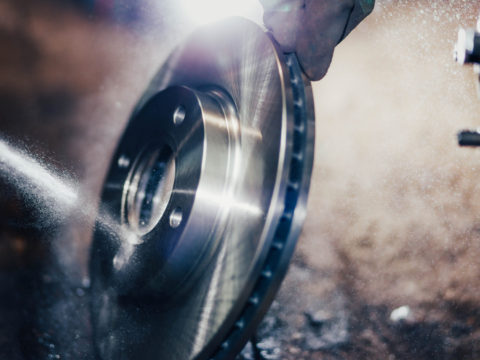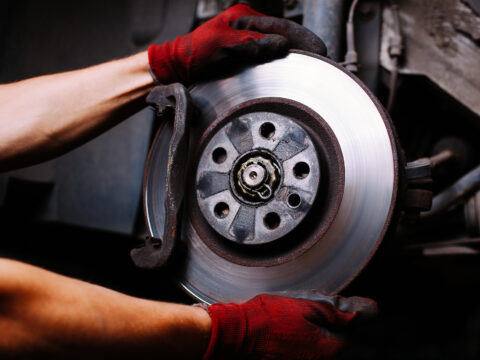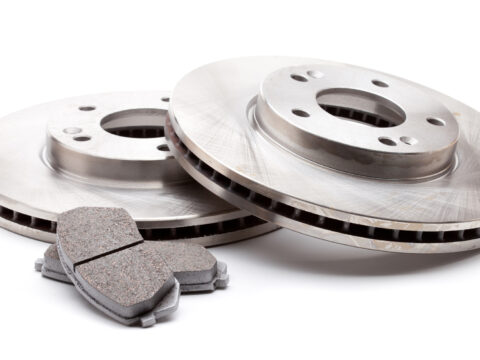Replacing your brake rotors is an essential step to maintaining your vehicle. But how often do you need to replace your brake rotors? On average, it is best practice to replace your brake rotors every 30,000-70,000 miles.
Whether you are a DIY expert or prefer to let the professionals handle your vehicle maintenance, knowing when to replace your rotors helps ensure you and your passengers’ safety.
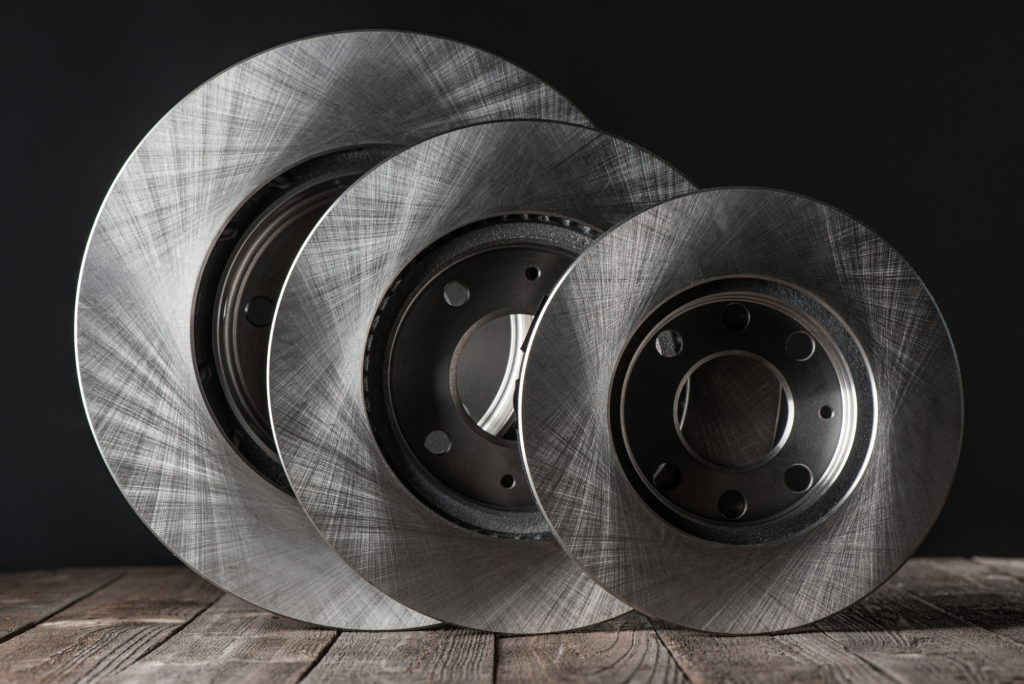
Brake rotors are an essential component of your vehicle’s braking system. When you apply the brakes to come to a stop when driving, your brake pads and shoes press against the brake drum or rotor.
Therefore, brake rotors create the friction needed to help your brake pads bring your vehicle to a stop. Made of metal, the brake rotors are in a disc-like shape and are inside each wheel. Brake rotors are a part of the disc brake system.
Brake rotor diagram
Whether you have a vented rotor or a solid rotor, the parts that makeup the brake rotor are minimal, but make up a large portion of the overall size of your vehicle’s braking system.
- Plate or disc
- Vented slots (only on the vented rotor)
- Mounting extension
Each part serves a specific purpose and is necessary for the rotors to work properly.
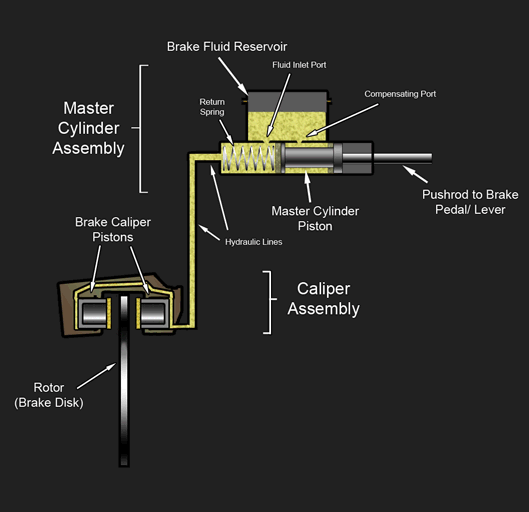
Contents
Functions of brake rotors
The function of brake rotors is to help stop your car. But how do they help stop your car? Rotors are specifically designed to change the motion of the turning wheel into thermal energy. In short, brake rotors change kinetic energy into heat.
When this process happens, the friction that is created when the calipers squeeze the rotors brings the vehicle to a stop. Without the brake rotors, your car would not respond as quickly when the brakes are applied, which creates a delayed response. This ultimately causes a driving hazard that could lead to an accident.
How long do rotors last on average?
On average, brake rotors last 30,000-70,000 miles. While they are one of the more durable parts of your car, brake rotors experience extensive wear that eventually causes them to wear out and not function to the best of their ability.
To ensure your brake rotors are up to par and functioning effectively, try to replace them every 30,000-70,000 miles.
How do you know when to replace brake rotors?
Bad brake rotors can go bad in several different ways including warping and extreme wear.
When brake rotors warp, they become uneven, causing your vehicle to have issues stopping when the brakes are applied. Similarly, when rotors experience excessive wear, they may not work as efficiently as before meaning, an extended braking period is necessary.
You can’t inspect your rotors every time you hop in your car to go somewhere. So how do you know when the best time is to replace your brake rotors? Here are several indicators that your brake rotors need to be replaced.
1) Visible Damage
While driving your vehicle and feeling how your car reacts to the brakes is a strong indicator of the current state of your brake rotors; you can also determine if they need to change visually. New brake rotors are almost smooth, whereas worn rotors are grooved or heavily scored.
2) Pulsing
Pulsing when braking is a strong indicator that your brake rotors need to be replaced. This is typically due to the uneven wear on your rotors which causes the brake pads to pulse when creating friction on the rotor.
3) Grinding
If your brakes grind when you brake, your rotors and pads are extremely worn and need to be changed immediately. The grinding is metal on metal, working to stop your vehicle. It is hard to create the necessary friction to effectively stop the car.
4) Squealing
Another sign of worn brake rotors is squealing. When you go to brake and hear a squealing noise, it is likely time to replace your brake rotors.
5) Vibration
When your rotors experience extreme wear, they may become warped. When this happens, the brake pads don’t line up with the rotors perfectly, causing the vehicle to vibrate when the brakes are applied.

How often to replace brake rotors?
While you don’t have to replace all four brake rotors at the same time, it is good practice to replace two at a time. If you need to replace a front rotor, go ahead and replace both front rotors; likewise with the rear rotors. This ensures even wear on your new rotors and smoother braking.
Rear rotors
As previously stated, your brake rotors need replacing between every 30,000-70,000 miles. However, the fact that rear rotors wear slower than front rotors means that your rear rotors can last until the tail end of the suggested replacement mileage.
As a rule of thumb, rear brakes should never produce more than 40% of the stopping power when the brakes are applied. Rear brakes and rotors have a specific design for stability.
Front rotors
Front rotors experience more wear due to the higher heat levels they endure. Why, you ask? When your vehicle is moving forward, and you apply the brakes, the momentum of the car is still moving forward. This means more pressure is on the front rotors causing them to provide 75% of the vehicle’s stopping force.
With so much of the stopping force relying on the front rotors, they produce higher heat levels, which causes them to wear faster. All of this to say, front rotors should be monitored more closely than rear rotors and retire on the lower end of their suggested mileage.
Who makes the best quality brake rotors?
BrakeBest Select
An exclusive O’Reilly Automotive brand, BrakeBest Select brake rotors are made of premium materials as BrakeBest strives to set the standard for brake system maintenance and repair. BrakeBest Select brake rotors are known to deliver quieter, smoother stopping power, longer life, and extensive resistance to warping. This means years of safe and reliable braking performance.
Bosch
Bosch brake rotors are an affordable option that provides high-quality braking ability. The design of these rotors is to prevent brake judder, noise, and vibration. Feature benefits include OE-Equivalent and direct fit replacement, prevent rust and corrosion with clear-look coating protection, are 100% balanced for smooth operation, and provide a clean look.
ACDelco
ACDelco brake rotors are complete with Ferritic Nitro-Carburizing technology for strength and durability. The cast-iron surface on these rotors can withstand extensive heat with an extra layer of defense against corrosion threats. ACDelco brake rotors are recommended for GM vehicles and have the full support of General Motors.
Power Stop
Specific to a performance design, Power Stop brake rotors contain slots for improved brake cooling and performance. These brakes are 100% dynamic mill-balanced, have a slotted friction surface that sweeps away gasses, dust, and water, and match the original equipment design for weight and vane count.
Proformer
Profermer brake rotors are a NAPA brand created for consistent performance at an affordable price. These brakes are 100% inspected and balanced for optimal weight distribution, have a 100% non-directional finish to prevent noise when breaking them in, and are 100% manufactured to SAE G3000 standards.
Brake rotors FAQs
Can I replace brake rotors without replacing pads?
Yes, you can replace brake rotors without replacing the pads. However, you must check the wear on the brake pads. If they have less than 70% life in them, you should go ahead and replace the pads to save time and money.
Do ceramic brake pads wear rotors faster?
Quite the opposite. Ceramic brake pads provide better noise control while doing less damage to the rotors. This means your brake rotors will last longer with ceramic brake pads.
How much does it cost to replace brake rotors?
While pricing varies depending on the mechanic, the average cost to replace your brake rotors is $250-$400 per axle. If you prefer to DIY your brake rotor replacement, you will pay approximately $70 per rotor depending on the brand of rotor you choose.
Is it hard to change brake pads and rotors?
While it is not difficult to replace brake pads and rotors, it is a time-consuming task and requires specific tools to ensure you get the job done right.
Is it ok to paint brake rotors?
No, it is not acceptable to paint brake rotors. The paint contains harsh chemicals that can contaminate the brake pads. This ultimately changes the friction levels, which changes the vehicle’s braking ability.


